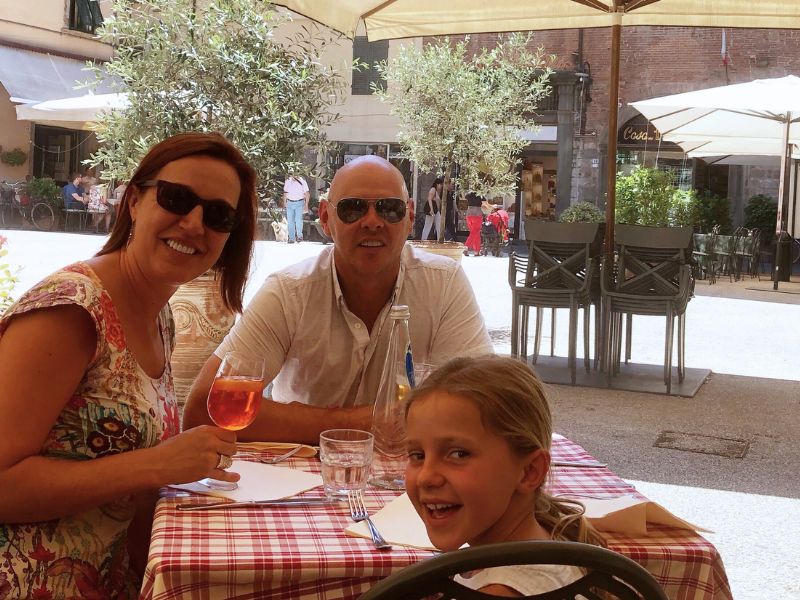‘Growth at all costs’ is a pointless business maxim. The media is full of stories of massive multinational brands that have failed to ever make a profit, despite headline-grabbing rates of growth. Growth, profit, and time you invest – these don’t correlate.
Since starting my business in 2008, I’ve deliberately grown, held, and shrunk as needed. Following the arrival of two babies in less than two years, things got pretty intense, and so I kept my business in a holding pattern, servicing clients, but not growing.
My partner (also self-employed) and I met while traveling, and still love travel.
In 2013, we rented a big house in France for six weeks, invited a rolling entourage of family and friends. In 2017, we went to Portugal for six weeks, and in 2019, we had seven weeks celebrating my fortieth in Greece with family and friends, followed by a road trip to Italy.
In September, we’ll be taking six weeks to return to Italy, then England.
Perhaps you also love traveling, or you want to work less, or you have a job and are growing a side business. Perhaps, like one of my one-to-one business coaching clients, you’re working full-time while buying businesses on the side.
Whatever your motivations to work less, this is how to run your business in minimal hours.
Plan your time
Abraham Lincoln said, “Give me six hours to chop down a tree and I will spend the first four sharpening the axe”.
Planning may seem like a waste of time when you have very little, but this is short-sighted. Planning is critical to ensure we’re spending our precious time on the right things. Planning in 90-day sprints ensures that you have a detailed, week-by-week action plan to focus only on the most important activities.
The first two things to plan are your marketing and sales.
The two key pillars of marketing and sales
Marketing is the lifeblood of your business because it keeps your leads coming. Stop-start marketing, sporadic pitching and random reach-outs means you’re making business harder than it needs to be because there’s no efficiency, strategy, nor momentum.
My Minimum Viable Marketing Plan™ is one piece of long-form per month, one email (which promotes your newest long-form content), social media marketing scheduling, and reach-outs. Reach-outs mean that you’re always focusing on building relationships: fostering a social attitude, generosity, following your curiosity, and staying top-of-mind with people.
Optimise your sales process to work to your capacity and communication strengths, and increase conversion.
Using a scheduling tool (I use Acuity Scheduling) and opening only a few defined times per week ensures that you’re not blindsided by a sales call that you’re not prepared for. Each call booked through Acuity necessitates people filling out a form, which means both parties are prepared, and we can use our time well.
Having (very) limited hours is no excuse for leaving people hanging. Remember, it’s not the most qualified person who gets the job, but it’s often the most enthusiastic (in other words, respond to people!).
Following up and pursuing opportunities
There’s no point doing marketing to generate interest if you then fail to pursue and follow up with prospects.
Ensure you have a list of leads with notes against each about when you last followed up, and why. Put follow-up dates in your calendar so that you don’t overlook this.
The Pareto principle applied to your offerings
The Pareto Principle – that 80% of our results come from 20% of our efforts – can be profitably applied to your offerings.
Most business owners invest an inordinate amount of time in offerings that:
a) Aren’t highly profitable
b) Don’t lead to other, more profitable offerings
c) Serve little strategic purpose.
Don’t let the squeaky wheel get the most oil. Implement a ‘minimum engagement fee’, below which you will not entertain.
Be strict with your process around client communications, repeatedly communicate this to clients, and always in their best interests, and ensure that you’re spending time where it’s valued: with clients who are paying well for it.
There are several different strategies you can employ to minimise contact with a client who is unnecessarily jeopardising your time and attention. But these start and end with boundaries.
It’s not enough to state your boundaries; you need to reinforce them. I had one client who kept calling me on a Saturday morning; another made a habit of calling late afternoon Fridays. Both stopped calling when I stopped answering their calls.
Becoming wise
Humans are very talented at filling time and the more time you have, the easier it is to fill it. But creativity loves constraints. The less time you have to run your business, the more you can sharpen your discernment and hone your focus.
It is not the hours invested that grows a business, it’s what you do with the time you have. In just 20 minutes, you can either write and send a proposal that lands a $10,000 job, or make pretty pictures in Canva.
Becoming wise doesn’t happen through reading a book or taking a course. It happens through challenging your thinking, making mistakes, reshaping your environment, backing yourself, and becoming clear on how you want to spend your precious time and focus.
Running your business in minimal hours isn’t easy. It’s hard to exercise self-restraint with emails that seem urgent. But learning how to run a profitable business in minimal hours can be a great first step in ensuring your business is sustainable and that they time and efforts you put in are being well-rewarded. In fact, it could be the smartest thing you’ve done in business yet.
Plan your year in 90-day sprints! Join us at Business Reset.





